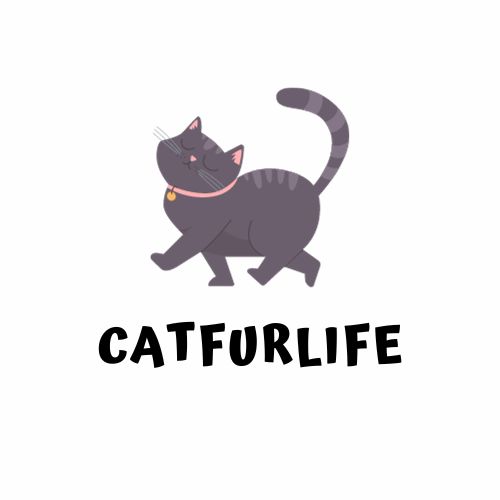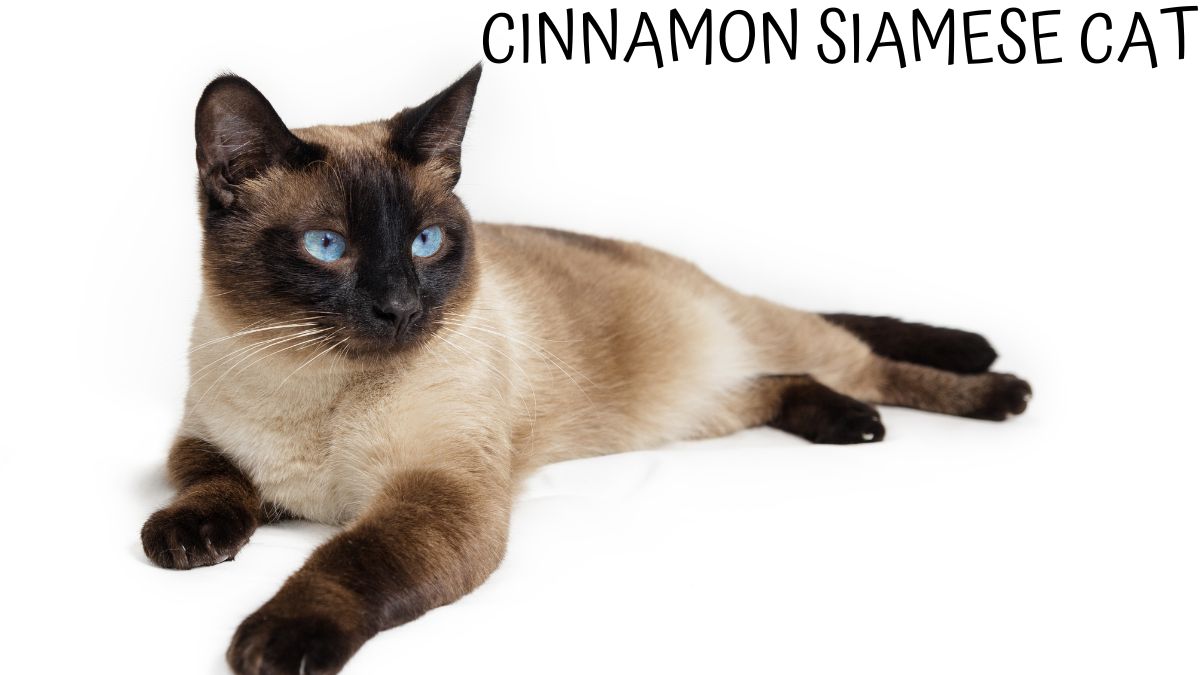With its elegant lines and expressive blue eyes, the Siamese cat breed has been a constant companion to cat fanciers for generations.
Among its spectrum of colors, the cinnamon variant, a warm, burnished reddish-brown, stands out for its rarity and beauty.
This article will weave through the genetic tapestry that gives rise to the cinnamon points and their related colorations, discuss the breed standard, and offer insights into their personality and care.
Additionally, we’ll explore how the Siamese cat’s colors have been captured in art and photography, with nods to the trademarks of Alamy Ltd., a renowned player in the imagery market.
Genetics of the Cinnamon Siamese Cat
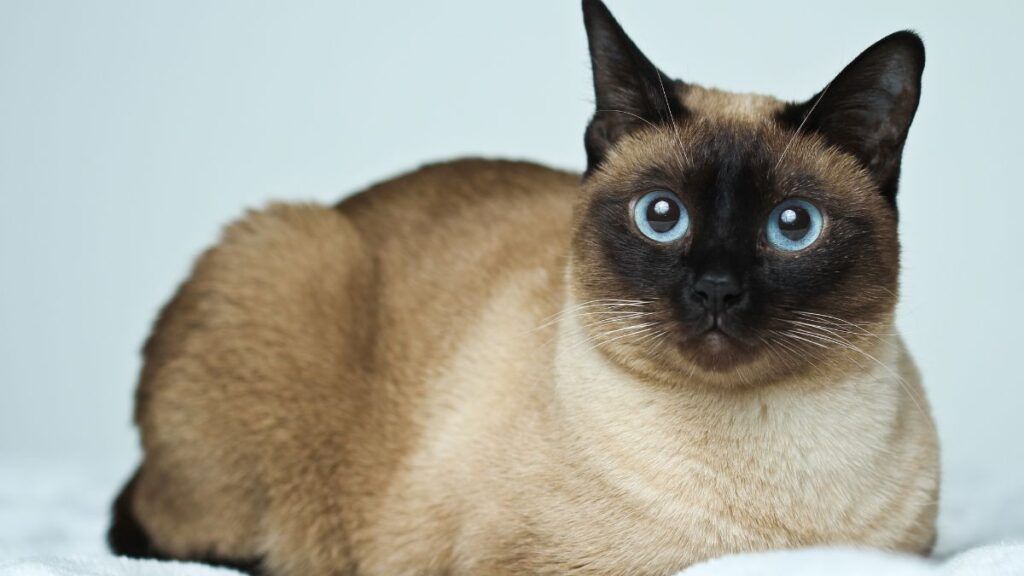
The coloration in Siamese cats, including the Cinnamon Siamese, results from partial albinism caused by a mutation in the tyrosinase enzyme.
This enzyme produces melanin, the pigment responsible for coloring in the skin and fur. In Siamese cats, this mutation causes the enzyme to be heat-sensitive, leading to darker coloration on the cooler parts of the body, such as the ears, face, paws, and tail, known as points.
Cinnamon Siamese cats specifically have a gene that dilutes the typical dark brown color to a lighter, warm, reddish-brown shade.
This gene is recessive, meaning a cat must inherit two copies to display the cinnamon color.
Other, more dominant genes can mask the gene for cinnamon coloration, so breeding for this color requires a good understanding of feline genetics to produce the desired shade.
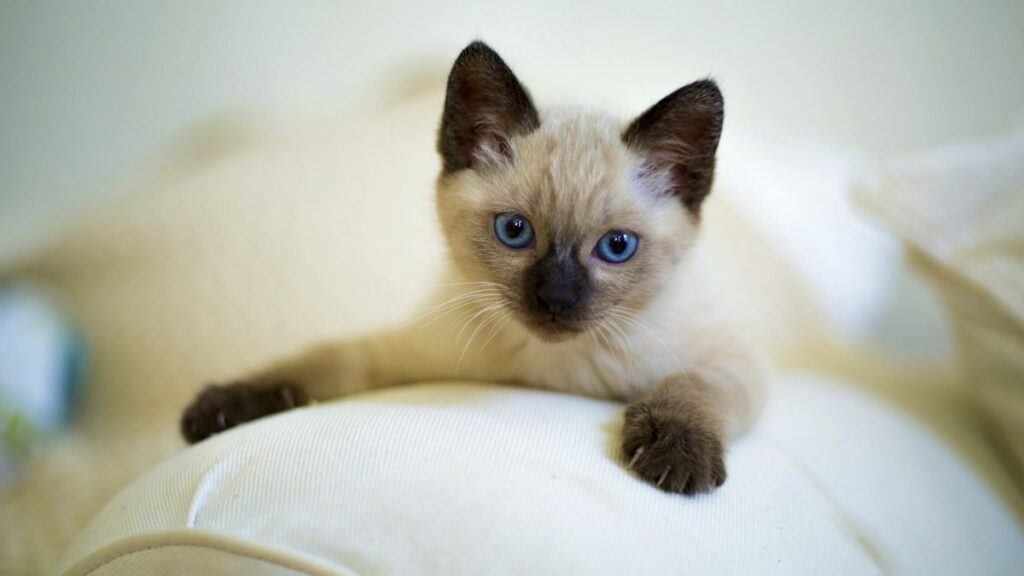
Personality Traits of Siamese Cats
While a cat’s personality can vary widely, Siamese cats are typically known for their outgoing and friendly nature.
They are often vocal and seek interaction and companionship from their humans. The Cinnamon Siamese, like its relatives, likely shares this inclination for engagement and may exhibit a playful and affectionate demeanor.
They are intelligent and curious, traits that make them trainable but also adept at getting into mischief. Siamese cats are as renowned for their distinctive personalities as they are for their unique color points and striking blue eyes.
They are among the most recognizable breeds in the world not just for their looks, but also for their charismatic and engaging personalities.
Vocalization
- Chatty Companions: Siamese cats are famous for their vocal nature. They have a unique voice, described as a loud, low-pitched, and raspy yowl or a persistent meow, which they use often to communicate with their owners. They are not shy about expressing their needs, desires, or discomforts.
- Vast Vocabulary: Siamese cats often have various vocalizations, with different ‘words’ for different situations, which some attentive owners claim to recognize and understand.
Affection and Attachment
- People-Oriented: These cats are incredibly affectionate and people-oriented. They tend to form strong bonds with their human companions and can be quite clingy. Siamese cats are known for following their owners around the house, seeking attention and interaction.
- Emotionally Expressive: Their emotional range is broad, and they are not afraid to show how they feel. A Siamese might demand cuddles, curl up on a lap, or reach out with a paw to touch their owner’s face, actively seeking a connection.
Intelligence and Curiosity
- Highly Intelligent: Siamese cats are brilliant, which makes them easily trainable but also means they require mental stimulation. They are quick learners and can be taught tricks or to walk on a leash.
- Curious Explorers: Their inquisitive nature drives them to explore every corner of their environment. They can be quite mischievous, opening cabinets and drawers or investigating any new item brought into their territory.
Playfulness and Activity
- Energetic and Playful: Siamese cats remain playful well into their adult years. They enjoy interactive play with humans or other pets and appreciate a good collection of toys, especially those that challenge their hunting instincts.
- Needs for Activity: Siamese cats need daily exercise to avoid becoming bored or developing destructive behaviors due to their high energy levels.
Social Nature
- Companionable with Other Pets: They often get along with other cats and dogs, significantly if raised together. Their social nature means they appreciate companionship, whether human or another pet.
- Dislike of Being Alone: Siamese cats generally do not like being alone for long periods. They thrive on attention and interaction, so they are not the best choice for someone frequently away from home.
Loyalty
- One-Person Cat: It’s often noted that Siamese cats may choose a favorite person in the household to whom they show particular affection. They can be very loyal to this person, often acting more like a devoted dog than a typical cat.
Adaptability
- Adaptable to Routine: Siamese cats can adapt well to routines and are happy indoors if they have sufficient space to play and explore.
The Siamese cat’s personality makes them much more than just pets; they are faithful family members.
Their need for interaction and mental engagement makes them particularly suited to homes where they will receive plenty of attention and love.
While their vocalization and clinginess might be overwhelming for some, for others, these traits make the Siamese an irreplaceable and loving companion whose blue eyes do indeed seem to look right into their owner’s soul.
Related: Differences Between These Two: Norwegian Forest Cat vs. Maine Coon
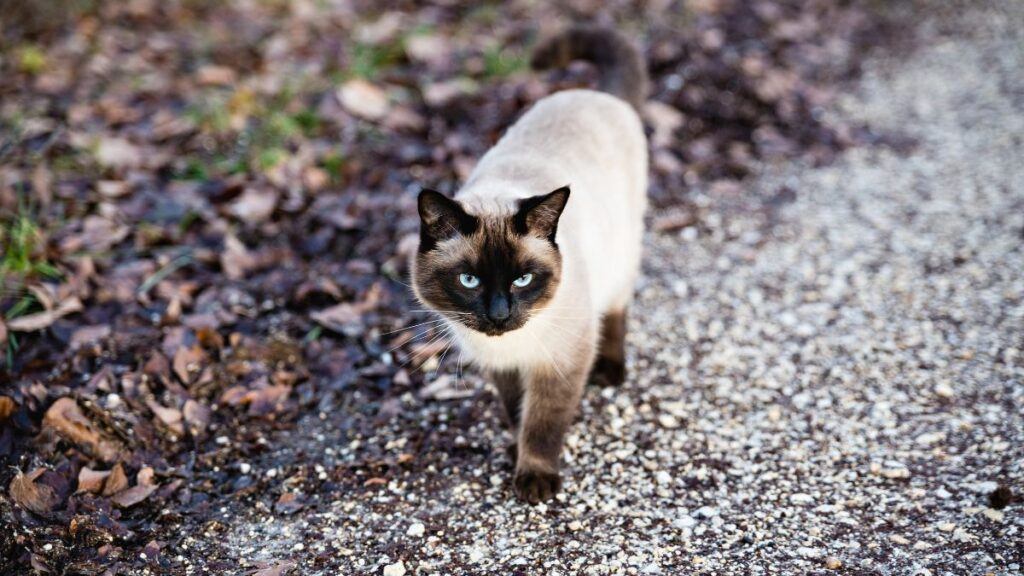
Physical Attributes of Cinnamon Siamese Cats
Cinnamon Siamese cats exhibit the same striking physical characteristics as other Siamese cats but with a unique coloration that distinguishes them from their counterparts.
Understanding the Cinnamon Siamese cat’s physical attributes highlights their beauty and helps explain how their appearance is influenced by genetics and aging.
Body and Point Coloration
Cinnamon Siamese cats possess the traditional body and point contrast that Siamese cats are famous for:
- Body: Their body is usually a warm white or cream tone. The body color tends to be lighter and serves as a backdrop that accentuates the distinct point coloration.
- Points: The points (ears, face mask, paws, and tail) display the characteristic cinnamon color, a light reddish-brown shade. The color at the points results from a temperature-sensitive enzyme that becomes active in the more excellent parts of the cat’s body.
Nose Leather and Paw Pads
The more minor details in Cinnamon Siamese cats further complement their coloration:
- Nose Leather: This is typically the same cinnamon color as the points. Sometimes, it can be slightly lighter or darker, depending on individual genetics and environmental factors.
- Paw Pads: These are also colored to match the points, giving a cohesive look to their extremities. This harmonious coloring of the nose leather and paw pads is a breed standard for Siamese cats and is a sought-after trait in show cats.
Facial Features
Siamese cats, including the Cinnamon Siamese, are known for their distinct facial features:
- Eyes: Their striking almond-shaped blue eyes are a signature trait of the breed. The intensity of the blue can vary, but it is always present, regardless of point coloration.
- Head Shape: The breed has a wedge-shaped head, a straight profile, and a fine, tapered muzzle.
Coat Texture
- Coat: The coat of a Siamese cat is short, sleek, and lies close to the body. This coat accentuates their svelte physique and is easy to care for.
Shadow Points
As Cinnamon Siamese cats age, their coloration can deepen into what is known as “shadow points”:
- Shadow Points: Over time, the light reddish-brown points can intensify, giving an even more pronounced color contrast with the body. This deepening of color is often gradual and may not be evenly distributed, leading to a shadowed effect.
Related: Do Maine Cats Have an M on their Forehead?
Aging and Color Intensity
The process of aging in Cinnamon Siamese cats can lead to changes in color intensity due to various factors:
- Thermal Sensitivity: The temperature-sensitive enzyme that regulates color intensity can lead to darker points in cooler climates or seasons.
- Hormonal Changes: Hormonal shifts can affect coat color, particularly in unneutered cats. Neutering often leads to a lighter coat as the cat matures.
- Genetic Factors: Individual genetics affect how the coloration develops and changes over time.
Cinnamon Siamese cats exhibit a beautiful symphony of physical attributes that align with the Siamese breed and the unique cinnamon shade that sets them apart.
Their striking coloration and elegant features result from a complex genetic process, which also allows for a fascinating progression of color as the cat matures.
From the point color matching the details of nose leather and paw pads to the potential for developing shadow points, the Cinnamon Siamese is a testament to the intricate genetics of coat coloration in felines.
Related: Maine Coon vs. Siberian: Similarities Between Both Cats
Health Considerations for Siamese Cats
Siamese cats are generally healthy and have a long lifespan, often living in their late teens or early twenties with proper care.
However, like all breeds, they have predispositions to specific health conditions. Prospective and current owners should know these potential health issues to ensure their Siamese cat lives healthy.
Health and Longevity
In some instances, selective breeding has led to health issues within the breed. Siamese cats are prone to certain genetic conditions, such as dental problems, heart issues like hypertrophic cardiomyopathy, and respiratory problems in more highly structured faces.
Responsible breeding practices aim to reduce the incidence of these. The evolution of the Siamese cat breed and its various color points and patterns clearly demonstrate how human preferences can sculpt the aesthetics and temperament of a breed over time.
While their stunning appearance and engaging personality make them beloved pets, ethical breeding practices cannot be overstated in ensuring the health and well-being of Siamese cats and their varieties.
Genetic Conditions
- Amyloidosis: Siamese cats can be prone to amyloidosis, where abnormal protein deposits can accumulate in organs, primarily the liver, potentially leading to organ dysfunction.
- Asthma/Respiratory Issues: Some Siamese cats may develop asthma or other respiratory problems. Medication can manage this and reduce environmental stressors that trigger respiratory difficulties.
- Congenital Heart Defects: Like many breeds, they can be predisposed to heart conditions such as congenital heart defects, including aortic stenosis.
- Crossed Eyes (Strabismus): This is less common in Siamese cats than it once was, but it can still occur. It’s largely cosmetic and does not usually impact the cat’s quality of life.
- Dental Issues: Due to the structure of their mouths, Siamese cats may be more likely to develop dental issues like gingivitis or periodontal disease. Regular dental check-ups and cleanings are important.
- Gastrointestinal Problems: They can experience megacolon or inflammatory bowel disease, which can be managed with diet and medication.
Progressive Retinal Atrophy (PRA)
- Siamese cats can suffer from an inherited form of progressive retinal atrophy, where the photoreceptor cells in the eyes degenerate, leading to potential blindness. Genetic testing can identify carriers of PRA.
Cancer
- Older Siamese cats may have a higher risk of certain types of cancer, such as lymphoma. Early detection and treatment can be critical.
Behavioral Health
- Siamese cats are highly social and can suffer separation anxiety or stress if left alone for extended periods. It’s essential to provide an enriching environment and companionship.
General Health Care
- Regular Vet Check-ups: Routine veterinary care can catch many health issues before they become serious.
- Vaccinations and Preventative Care: Keeping up with vaccinations and preventative treatments for parasites is essential.
- Spaying/Neutering: This can prevent unwanted litter and reduce the risk of certain diseases.
- Balanced Diet: A healthy diet is crucial for overall health.
- Exercise: Regular play and activity help keep a Siamese cat physically fit and mentally stimulated.
Genetic Testing and Breeding Considerations
- Breeders should employ genetic testing to screen for common heritable conditions in the breed.
- Obtaining Siamese cats from reputable breeders who use responsible breeding practices to reduce the likelihood of inherited health problems is also advised.
Being informed about the health considerations of Siamese cats allows owners to provide the best care possible.
With regular veterinary check-ups, a healthy lifestyle, and an attentive eye for signs of illness, Siamese cats can enjoy a high quality of life.
Owners dedicated to their well-being will find a loving and loyal companion in this charismatic breed.
Related: The Allure of the Maine Coon Lynx Mix
Care Considerations for Cinnamon Siamese Cats
Grooming
- Coat Care: The short coat of a Cinnamon Siamese cat is typically low-maintenance. However, regular brushing (once a week) helps remove loose hair and distribute skin oils, which keeps their coat shiny and healthy.
- Bathing: Siamese cats generally keep themselves very clean. Frequent baths are not necessary and may even be stressful for the cat. A bath every few months or as needed should be sufficient unless the cat gets into something particularly messy.
- Nail Trimming: Regular nail trims are important to prevent overgrowth, splitting, and potential injury. This can be done every couple of weeks.
- Ear Cleaning: Check their ears regularly for signs of dirt buildup or infection and clean them as a veterinarian recommends.
- Dental Hygiene: Dental care is crucial, so brushing their teeth with vet-approved toothpaste can prevent dental diseases.
Diet and Nutrition
- Quality Diet: A balanced diet suited to their age, size, and activity level will support their health. High-quality commercial cat food rich in protein is typically recommended for Siamese cats.
- Fresh Water: Always ensure access to clean water, as proper hydration is essential for their overall health.
Environmental Enrichment
- Playtime: Siamese cats are highly active and intelligent, so they need plenty of playtime with toys that stimulate their hunting instincts, such as feather wands or laser pointers.
- Mental Stimulation: Puzzle feeders and interactive toys can keep them mentally engaged, essential to prevent boredom and destructive behaviors.
- Climbing and Perching: Providing cat trees or shelves for climbing and perching can help satisfy their need to explore and observe their surroundings from different heights.
Social Interaction
- Companionship: As sociable creatures, they need interaction with their human family members. They can become depressed or anxious if left alone for extended periods regularly.
- Socialization: Early socialization with different people, pets, and environments can help them become well-adjusted adults.
Exercise
- Daily Exercise: Ensure your Cinnamon Siamese cat gets daily exercise to maintain a healthy weight and muscle tone. Interactive games can serve this purpose well.
- Outdoor Access: Providing safe outdoor access can be beneficial, but always ensure it is secure. Many Siamese cats can be leash-trained for outdoor walks.
Health Monitoring
- Regular Check-ups: Annual veterinary check-ups are vital for monitoring health, catching potential problems early, and keeping vaccinations current.
- Watch for Signs of Illness: Siamese cats can hide illness well, so it’s essential to be vigilant and seek veterinary advice if you notice changes in behavior, appetite, or litter box habits.
Emotional Well-being
- Routine: Maintain a consistent routine, as Siamese cats often like predictability daily.
- Safe Space: Provide a safe, quiet space for them to retreat when they feel stressed or want privacy.
Training
- Behavioral Training: They respond well to positive reinforcement training, so encourage good behavior with treats and praise.
- Litter Training: Siamese cats are usually very easy to litter train, but keeping their litter box clean is vital to prevent any avoidance issues.
Caring for a Cinnamon Siamese cat involves proper grooming, a balanced diet, regular veterinary care, and plenty of mental and physical stimulation.
As with any pet, providing love and attention is critical. A well-cared-for Siamese is a happy, healthy, and affectionate companion who will enrich your life with their vibrant personality.
Related: Maine Coon vs. Siberian: Similarities Between Both Cats
Origin and Evolution of the Siamese Breed
The Siamese cat is one of the oldest and most recognizable cat breeds. It originated in Thailand, which was then known as Siam. These cats were revered and often found in royal households.
Early Siamese cats were quite different from modern ones. They had a rounder body and face, and their coat colors were less sharply defined than the pointed patterns we associate with the breed now.
As Siamese cats were exported to Western countries, breeders began to select for specific traits, such as a more slender body, a wedge-shaped head, and striking blue almond-shaped eyes.
This breeding led to what is now known as the modern Siamese, which exhibits a more extreme set of features than the traditional Siamese, sometimes referred to as the “Applehead” due to its rounder head shape.
Breed Varieties and Points
The term “point” refers to the coloration on the body’s extremities: the face, ears, paws, and tail.
In Siamese cats, these points result from a temperature-sensitive enzyme that causes the fur to darken in more excellent parts of the body.
Over time, breeders have developed various point colorations and patterns in Siamese cats:
- Cinnamon Point Siamese: This variety features a warm, cinnamon-brown coloring at the points. It’s one of the rarer colorations resulting from specific genetic mutations affecting coat color.
- Tabby Point or Lynx Point Siamese: This variety has the typical body of a Siamese but with the striped pattern of a tabby cat at the points. These stripes can range from light to dark and add a striking contrast to the cat’s body.
- Caramel Point Siamese: This variety has a dilute point color that looks like a muted, grayish-brown hue, giving them a softer appearance than the more contrasted points.
Genetic Diversity and Breeding
Selective breeding has been used to enhance and preserve the cinnamon coloration and tabby patterns in Siamese cats and their relatives. Breeders need to be well-versed in the principles of genetics to predict the outcomes of matings and to ensure a diverse and healthy gene pool.
It’s worth noting that while the genetic makeup lays the groundwork for the cat’s potential color, environmental factors and modifier genes can also influence the final appearance.
For instance, some cats may develop slightly darker or lighter shades of cinnamon as they age or during different seasons.
Cinnamon coloration in Siamese and related breeds is a beautiful example of the complexity and variety that genetics can achieve.
It represents a symphony of recessive alleles working harmoniously to produce the warm, reddish-brown tones that distinguish these cats.
Adding the tabby pattern into the mix further showcases the intricate genetic tapestry that contributes to the diversity and allure of the feline coat.
The genetic basis for the Siamese cat’s coat color is tied to a form of partial albinism.
The enzyme responsible for producing pigment in the fur is less effective at the cat’s higher body temperature, leading to lighter fur on the warmer parts of the body (such as the torso) and darker fur on the cooler extremities.
The variations in point color, such as cinnamon, caramel, or tabby, arise from other genetic factors, including mutations and the presence of modifying genes.
These genetic factors can be complex, as they involve the inheritance of the main color gene and the modifying genes that influence the expression of these colors.
Breeding and Care
When breeding Siamese cats, it’s essential to maintain genetic diversity while selecting the desired physical and temperamental traits.
Breeders must be knowledgeable about the genetics of coat colors and patterns to predict the appearance of offspring and avoid health issues associated with specific genetic combinations.
Like all breeds, proper care for Siamese cats involves meeting their physical, nutritional, and emotional needs.
Siamese cats are known for being very social and vocal. They often form strong bonds with their human companions and require lots of interaction and mental stimulation.
Related: Manx Maine Coon Mix Cat: A Stubby Tailed Feline Breed
Historical Context and Evolution of Siamese Cats
Ancient Beginnings
One of the oldest and most distinctly recognized cat breeds is the Siamese. Originating from Thailand, which was once known as Siam, this cat is revered in cat history for its elegant features and striking color contrasts.
These cats were so esteemed that they were often found in royal households and Buddhist monasteries, where they were thought to receive the transmigrated souls of departed royalty, granting them a status almost divine.
Spread to the Western World
Siamese cats were first officially introduced to the Western world in the late 19th century. They made a significant impression in England when one was showcased at the Crystal Palace Cat Show in 1871.
Despite initial mixed reviews about their unusual appearance, their popularity grew, and they became highly sought after by aristocrats and breed enthusiasts. As they were gifted, bred, and sold, their presence spread across Europe and eventually to North America.
Siamese Cats in Different Countries
The allure of the Siamese cat took hold in the United States in the early 20th century, when breeders began refining and standardizing the breed.
Each country that embraced the Siamese cat saw breeders selecting for particular traits, leading to variations in body type and coloration.
For instance, the British Siamese maintained a more moderate body type, while the American breeders developed the more extreme slender, elongated features known in the modern Siamese.
Emergence of the Cinnamon Siamese
Among the numerous color variations, the Cinnamon Siamese emerged as a color mutation that was initially less known and relatively rare.
It wasn’t one of the four classic Siamese colors (seal, blue, chocolate, and lilac points) recognized when the breed was first standardized in the West.
However, as breeding programs expanded and the understanding of genetics deepened, the cinnamon coloration began to be deliberately sought after.
While maintaining the breed’s traditional physical features and character, this variant offered a new, warm hue that enriched the Siamese color palette.
It took some time for the Cinnamon Siamese to gain recognition, but once it did, it quickly became a part of the breed’s enchanting array, celebrated for its beauty and rarity.
Cultural Significance
Siamese cats captured hearts in every country they graced with their expressive blue eyes and vocal personalities. They’ve been featured in art, film, and literature, cementing their place in popular culture.
The Cinnamon Siamese carries this legacy forward, adding its unique charm to the tapestry of the breed’s rich history.
While the cinnamon Siamese cat is a more recent addition to the recognized colors of the breed, it carries with it the storied past of the Siamese cat’s evolution from the temples of ancient Siam to the varied and cosmopolitan locales of today.
This variant upholds the tradition of elegance and distinction that has characterized Siamese cats throughout history, making it a valued and exotic member of the feline world.
Its presence underscores the breed’s ability to adapt and evolve while retaining the charisma and appeal that have made Siamese cats beloved companions through the ages.
Related: Maine Coon Mix Characteristics:
The Palette of Siamese Cat Colors and Patterns
The fascinating cThe Palette of Siamese Cat Colors and Patternsinnamon hue seen in Siamese cats and their closely related kin like the Oriental Shorthair is indeed an enchanting genetic marvel.
To understand this coloration, it’s essential to delve into the basics of feline coat genetics. Siamese cats are renowned for their striking point color contrast, the breed’s hallmark.
This distinctive coloration is not just a matter of aesthetic beauty but a result of fascinating genetic interactions. As they age, Siamese cats often go through a transformation, with their points darkening and becoming more pronounced against their paler body color.
Let’s explore the range of colors and patterns found in Siamese cats.
Traditional Siamese Cat Colors
The traditional Siamese colors, recognized from the earliest breed standards, include:
- Seal Point: The darkest of the traditional Siamese colors, with deep brown, almost black points.
- Chocolate Point: A lighter brown, giving a milk chocolate appearance.
- Blue Point: A cool-toned, slate-gray coloration.
- Lilac Point: The lightest of the traditional colors, a pale, warm gray with a pinkish tone.
Kitten Color Development
Siamese kittens are born with a completely white or cream-colored coat, and their points develop color as they grow older.
The coloration process is temperature-dependent, with the more excellent body parts (the extremities) displaying the darker color. This color development can take up to a year to fully mature and is influenced by the ambient temperature and the cat’s body temperature.
Genetics Behind the Colors
The genetic mechanism behind these colors is linked to a mutation in the tyrosinase gene, which creates temperature-sensitive enzymes responsible for pigment production.
This mutation restricts pigmentation to the more excellent body parts, hence the characteristic points. Modifier genes and the primary color genes (such as black and orange) determine the specific color and pattern.
The colorful world of Siamese cats is a testament to the wonders of genetics, from the deep, rich tones of the seal points to the delicate shades of the cream points and from the striking patterns of the tabby points to the intricate mosaics of the tortie points.
The Siamese breed offers a color and pattern for every preference. The journey of color development as kittens grow into their points adds to the mystique of the breed, making them a continuously evolving canvas of natural art.
Additional Recognized Colors
Over time, as breeding programs have developed and diversified, additional colors have been recognized in the Siamese breed:
The Basis of Feline Coat Color
Feline coat color is governed by genes that determine the color itself and the pattern and distribution. One of the primary genes responsible for the color of Siamese cats and their pointed pattern is the colorpoint gene, a variant of the albino series.
In Siamese cats, this gene interacts with temperature, leading to the development of color on the more excellent parts of the body.
The Cinnamon Allele
Within this framework, the cinnamon coloration is caused by a specific allele at the b locus, which controls the expression of brown color in the cat’s coat. The b locus has several alleles that can lead to different shades of brown:
- B: The dominant allele, leading to black pigmentation.
- b: This leads to chocolate pigmentation. It’s a recessive allele, and a cat must inherit two copies (one from each parent) to exhibit the chocolate color.
- Bl: The cinnamon allele is recessive to both the B and b alleles. A cat with two copies of this allele (bl/bl) will express the cinnamon color.
The cinnamon allele dilutes the chocolate pigment to a lighter, warmer, reddish-brown shade, creating the distinct cinnamon point in these Siamese cats.
Related Breeds and Color Points
The genetics responsible for the cinnamon color are not exclusive to Siamese cats. They also occur in related breeds, such as the Oriental Shorthair, which originated from the Siamese but is recognized for its diversity in color and pattern.
These breeds are grouped under the designation “color point shorthairs” due to their shared characteristic of having a pale body with darker extremities or points.
The Tabby Pattern Overlay
The agouti gene, which controls whether a cat will have a solid or tabby coat pattern, adds another layer of complexity.
The cinnamon tabby point Siamese or Oriental Shorthair presents with an overlay of tabby patterning only on their points (ears, face mask, paws, and tail), while the rest of the body remains the lighter, warm, ivory base coat color.
- A: The dominant allele for the agouti gene allows the tabby pattern to be expressed.
- a: The non-agouti or solid allele is recessive, and cats with two copies (a/a) will not show a tabby pattern.
In cinnamon tabby point cats, the agouti gene works with the cinnamon allele to produce the delicate striped or spotted patterns superimposed on the warm cinnamon points.
This combination can result in beautiful cats with clearly defined tabby markings on their points, with complementary eye rims, noses, and paw pads that reflect their primary coat color.
Pattern Variations
Along with the solid point colors, pattern variations have also been embraced within the breed:
- Tabby Point (Lynx Point): Striped patterns appear on the points. The body remains pale, and the stripes can be seen in any Siamese point color.
- Tortie Point (Tortoiseshell Point): A mottled pattern of colors such as red or cream mixed with one of the other point colors, usually seal or chocolate. This pattern is exclusive to females, except for scarce male XXY individuals.
- Torbie Point: A combination
The Cinnamon Siamese cat emerges as a captivating tapestry woven from the threads of genetic diversity, cultural history, and aesthetic beauty.
With their warm, cinnamon-hued points and beguiling blue eyes, these felines are more than just a pet; they are a study in the art of nature’s palette.
Their coloration, from the soft glow of apricot points to the deep, rich cinnamon tortie tabby points, is an ongoing dance of recessive alleles and breeding finesse.
The subtle gradation of their color, from the delicate frost point to the dramatic seal point, encapsulates the depth of the Siamese breed standard and its fascinating evolution across different countries and breeders’ hands.
The interplay of light and shadow across their lithe bodies, the unique patterns of their tabby markings, and the softness of their pale coats speak to an elegance that has been celebrated in various forms, from the carefully curated shop Alamy prints store to the devoted cat fanciers’ associations.
Yet, the Cinnamon Siamese cat is not solely an ornament but a constant companion whose personality is as vibrant and warm as its coat. Their vocalizations and affectionate demeanor make them an integral part of countless families, a source of joy, and a centerpiece in homes worldwide.
In recognizing the Cinnamon Siamese cat, we must also be mindful of the responsibilities of guardianship. Awareness of potential health problems, ensuring delivery times for their care, and providing love and attention are all parts of the stewardship of these feline friends.
As they grace our lives with their presence, we are reminded of the delicate balance between nurturing their health and celebrating their beauty.
The Cinnamon Siamese cat is a remarkable fusion of history, science, and art. Each cat carries the legacy of the first Siamese cats, the ingenuity of breeders, and the enchantment of a breed that has captivated hearts for generations.
As we look into those deep blue eyes, we see not just a cat but a living mosaic of the Siamese legacy, which continues to thrive and expand in the loving homes and hearts of those they enchant.
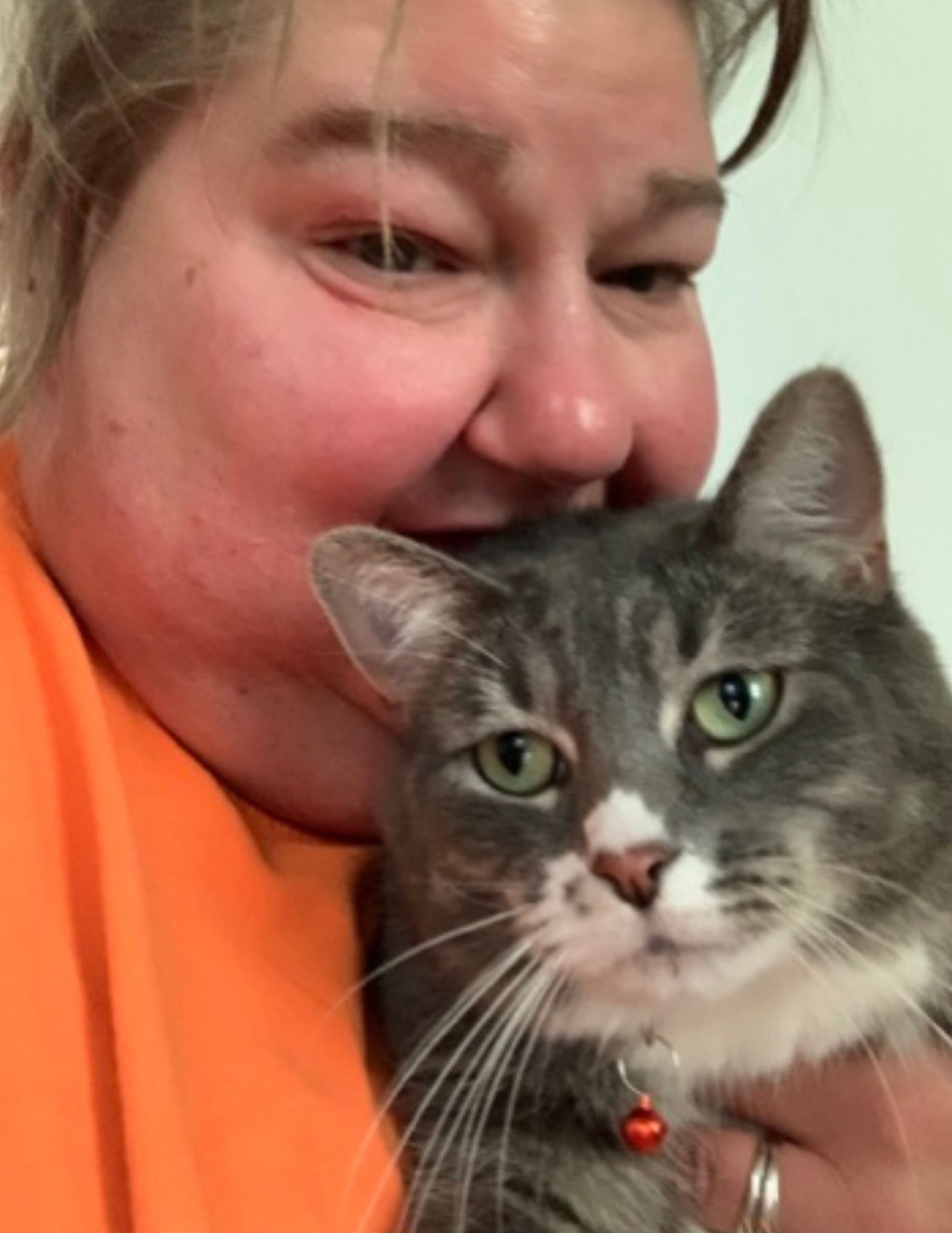
Meet Ann Haasnoot, the passionate founder of CatFurLife.com. A lifelong cat lover from Wisconsin, Ann combines her extensive feline behavior and care knowledge with her love for writing. On her website, she shares invaluable insights about cat breeds, care tips, and her experiences with her beloved furbaby, aiming to deepen the bond between cats and their human companions.
